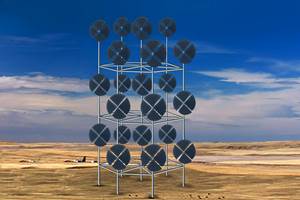Duke Energy announces wind energy project
A consortium of four companies propose a massive wind farm and energy storage facility to supply Los Angeles.
Four companies jointly proposed on September 24 a first-in-the-U.S., $8 billion green energy initiative that would bring large amounts of clean electricity to the Los Angeles area by 2023. The project would require construction of one of America’s largest wind farms in Wyoming, one of the world’s biggest energy storage facilities in Utah, and a 525-mile electric transmission line connecting the two sites.
“This project would be the 21st century’s Hoover Dam – a landmark of the clean energy revolution,” says Jeff Meyer, managing partner of Pathfinder Renewable Wind Energy, one of the four companies involved in the initiative. The proposed project would generate more than twice the amount of electricity produced by the giant 1930s-era hydroelectric dam in Nevada – 9.2 million megawatt-hours per year vs. 3.9 million megawatt-hours.
A key component of the project – a massive underground energy storage facility – would yield 1,200 megawatts of electricity, equivalent to the output of a large nuclear power plant and enough to serve an estimated 1.2 million L.A.-area homes.
The four companies – Pathfinder Renewable Wind Energy, Magnum Energy, Dresser-Rand and Duke-American Transmission – will formally submit their proposal to the Southern California Public Power Authority by early 2015 in response to the agency’s request for proposals to supply the Los Angeles area with renewable energy and electricity storage.
The underground energy storage facility would help solve one of renewable energy’s biggest challenges – its intermittency. Wind farms produce no electricity when there’s no wind; solar farms produce no electricity when there’s no sun. Linking the wind farm to the energy storage facility would enable the wind farm to function largely like a traditional coal, nuclear or natural gas power plant – capable of reliably delivering large amounts of electricity whenever needed, based on customer demand.
The energy storage facility also would reduce the need for L.A.area utilities to build expensive backup power plants and power lines to serve customers on days when there’s no wind, at night when there’s no sunlight, and during other periods when traditional wind and solar farms are unable to produce electricity.
Key components of proposed project : Wind farm – Pathfinder Renewable Wind Energy would build, own and operate the $4 billion wind farm near Chugwater, Wyo., 40 miles north of Cheyenne, which would generate 2,100 megawatts of electricity. Energy storage facility – Pathfinder Renewable Wind Energy, Magnum Energy and Dresser-Rand would install the $1.5 billion “compressed air energy storage” system at a site near Delta, Utah, 130 miles southwest of Salt Lake City. Four vertical caverns – carved out of an underground salt formation at the site – would be key components of the storage system. Each cavern would be about a quarter-mile in height, 290 feet in diameter and 41 million cubic feet in volume. The four caverns combined would store the energy equivalent of 60,000 megawatt-hours of electricity. During periods of low customer demand, the storage facility would use excess electricity from the Pathfinder wind farm to compress and inject high-pressure air into the caverns for storage. During periods of high customer demand, the facility would use the stored, high-pressure compressed air, combined with a small amount of natural gas, to power eight generators that would produce electricity. Electric transmission line – Duke-American Transmission proposes to build the $2.6 billion, 525-mile, high-voltage electric transmission line that would transport the Wyoming wind farm’s electricity to the Utah energy storage facility. The transmission line – a shorter alternative to Duke-American Transmission’s previously proposed 850-mile Zephyr transmission project – would traverse Wyoming, Colorado and Utah, with a target in-service date of 2023. A separate, existing 490-mile transmission line – traversing Utah, Nevada and California – would transport electricity from the Utah energy storage facility to the Los Angeles area.
Video about the project (5 minutes) is available here: https://www.youtube.com/watch?v=7i1OXVto6_w (https://www.youtube.com/watch?v=7i1OXVto6_w)
Related Content
ECOHYDRO project to enable recyclable composites for hydrogen storage
With the involvement of two schools from the Institut Mines-Télécom, the 4-year project aims to improve the intrinsic properties of a composite material based on Elium via four concrete demonstrators.
Read MoreCollins Aerospace to lead COCOLIH2T project
Project for thermoplastic composite liquid hydrogen tanks aims for two demonstrators and TRL 4 by 2025.
Read MoreDrag-based wind turbine design for higher energy capture
Claiming significantly higher power generation capacity than traditional blades, Xenecore aims to scale up its current monocoque, fan-shaped wind blades, made via compression molded carbon fiber/epoxy with I-beam ribs and microsphere structural foam.
Read MoreRecycling end-of-life composite parts: New methods, markets
From infrastructure solutions to consumer products, Polish recycler Anmet and Netherlands-based researchers are developing new methods for repurposing wind turbine blades and other composite parts.
Read MoreRead Next
“Structured air” TPS safeguards composite structures
Powered by an 85% air/15% pure polyimide aerogel, Blueshift’s novel material system protects structures during transient thermal events from -200°C to beyond 2400°C for rockets, battery boxes and more.
Read MoreAll-recycled, needle-punched nonwoven CFRP slashes carbon footprint of Formula 2 seat
Dallara and Tenowo collaborate to produce a race-ready Formula 2 seat using recycled carbon fiber, reducing CO2 emissions by 97.5% compared to virgin materials.
Read MoreDeveloping bonded composite repair for ships, offshore units
Bureau Veritas and industry partners issue guidelines and pave the way for certification via StrengthBond Offshore project.
Read More












.jpg;maxWidth=300;quality=90)









